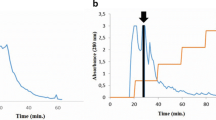Abstract
Agglutinating activity often varies both between and within the algal species assayed. However, it is difficulty to interpret such variation without further analysis. We report a statistical analysis of agglutinating activities against human, cow, sheep, and pig erythrocytes, using cell extracts from 43 taxa (strains) of freshwater microalgae. Most of the extracts agglutinated erythrocytes from at least one of the sources, but pig erythrocytes appeared to be most suitable for the detection of agglutination reactions. Chlorella cell extracts preferentially agglutinated human erythrocytes, whereas extracts of other taxa were less active against mammalian erythrocytes. Cluster analysis generated four distinct subclusters of taxa, characterized by different specificities for antigens or carbohydrate receptors on the erythrocytes. Principal component analysis further separated the agglutination characteristics of Chlamydomonas from Chlorella on the first two components. Specificity for pig erythrocytes accounted for most of the clustering or grouping of algal taxa in multivariate analysis. However, clustering or grouping patterns of Chlorella species on haemagglutinating activity resembled that based on DNA sequences, revealing a possible genetic connection of agglutinins and their biochemical characteristics in algal cells. Variability of agglutination reactions among the algae investigated is simplified and interpreted most easily using multivariate analysis.



Similar content being viewed by others
References
Blackith RE, Reyment RA (1971) Multivariate morphometrics. Academic Press, London
Blunden G, Rogers DJ, Farnham WF (1978) Haemagglutinins in British marine algae and their possible taxonomic value. In: Irvine DE, Price JH (eds) Modern approaches to the taxomomy of red and brown algae. Academic Press, London, pp 21–45
Boyd WC, Almodovar LR, Boyd LG (1966) Agglutinins in marine algae for human erythrocytes. Transfusion 6:82–83
Brown RM, John CJ, Bold HC (1968) Electron and phase-contrast microscopy of sexual reproduction in Chlamydomonas moewusii. J Phycol 4:100–120
Carmichael WW, Bent PE (1981) Haemagglutination method for detection of freshwater cyanobacteria (blue-green algae) toxins. Appl Env Microbiol 41:1383–1388
Chu CY, Liao WR, Lin LP (2005) Haemagglutinating activities from unicellular algae. Acta Ocenanogr Taiwanica 42:15–23
Chu CY, Huang R, Lin LP (2006) Purification and Characterization of a Novel Haemagglutinin from Chlorella pyrenoidosa. J Ind Microbiol Biotechnol 33:967–973
Fabregas J, Llovo J, Munoz A (1985) Haemagglutinins in red seaweeds. Bot Mar 28:517–520
Freitas ALP, Teixeira DIA, Costa FHF, Farias WRL, Lobato ASC, Sampaio AH, Benevides NMB (1997) A new survey of Brazilian marine algae for agglutinins. J Appl Phycol 9:495–501
Hori K, Miyazawa K, Ito K (1981) Haemagglutinins in marine algae. Bull Jap Soc Sci Fish 47:793–798
Hori K, Takehiko O, Hisao K, Mimuro M (1996) Lectin-like and lectin receptors in marine microalgae: Haemagglutination and reactivity with purified lectins. J Phycol 32:783–790
Illman AM, Scragg AH, Shales SW (2000) Increase in Chlorella strains calorific values when grown in low nitrogen medium. Enz Microbial Technol 27:631–635
Liao WR, Huang R (2000) Agglutination of human and animal erythrocytes in marine unicellular algae. J Ind Microbiol Biotechnol 24:262–266
Liao WR, Huang R, Su HM (2001) Haemagglutinating activity from marine microalgae. Nova Hedwigia Bei 122:99–106
Rogers DJ, Blunden G, Evans PR (1977) Ptilota plumosa, a new source of a blood-group B specific lectin. Med Lab Sci 34:193–200
Rogers DJ, Fish BC (1991) Marine algal lectins. In Kilpatrick DC, Van Driessche E, Bog-Hansen TC (eds), Lectin review. Sigma Chemical, St. Louis, pp 129–142
Rogers DJ, Blunden G, Topliss JA, Guiry MD (1980) A survey of some marine organisms for haemagglutinins. Bot Mar 23:569–577
Sato Y, Murakami M, Miyazawa K, Hori K (2000) Purification and characterization of a novel lectin from a freshwater cyanobacterium, Oscillatoria agardhii. Comp Biochem Physiol B 125:169–177
Saito T, Matsuda Y (1984) Sexual agglutinin of mating-typing minus gametes in Chlamydomonas reinhardii. II. Purification and characterization of minus agglutinin and comparison with plus agglutinin. Arch Microbiol 139:95–99
Sakamoto S, Yamaguchi M, Watanabe MF, Watanabe M, Kamiya H (1996) Distribution and characterization of lectins from natural and cultured Microcystis spp. In: Yasumoto T, Oshima Y, Fukuyo Y (eds). Harmful and Toxic Algal Blooms, Inter-Government Oceanographic Commission of UNESCO, pp 569–572
Tanaka K, Yamada A, Noda K (1998) A novel glycoprotein obtained from Chlorella vulgaris strain CK22 shows antimetastatic immunopotentiation. Canc Immunol Immu 45:313–320
Wu HL, Hseu RS, Lin LP (2001) Identification of Chlorella spp. isolates using ribosomal DNA sequences. Bot Bull Acad Sin 42:115–121
Yamaguchi M, Mituru J, Ryuichi S, Koji M, Kamiya H (1998) Purification and characterization of Microcysis aeruginosa (freshwater cyanobacterium) lectin. Comp Biochem Physiol B 119:593–597
Yamaguchi M, Ogawa T, Muramoto K, Kamio Y, Jimbo M, Kamiya H (1999) Isolation and characterization of a mannan-binding lectin from the freshwater cyanobacterium (blue-green algae) Microcystis viridis. Biochem Biophys Res Commun 265:703–708
Zar JH (1974) Biostatistical analysis. Prentice-Hall, EnglewoodCliffs, N.J.
Acknowledgements
We thank the National Science Council of the Republic of China (Taiwan) for supporting this study (NSC: 92-2317-B-002-030). We also thank Mr. Chen Yua-Sin (Good Biotech Co.) for providing erythrocytes for agglutination assay.
Author information
Authors and Affiliations
Corresponding author
Rights and permissions
About this article
Cite this article
Chu, CY., Huang, R. & Lin, LP. Analysis of the agglutinating activity from unicellular algae. J Appl Phycol 19, 401–408 (2007). https://doi.org/10.1007/s10811-006-9146-3
Received:
Accepted:
Published:
Issue Date:
DOI: https://doi.org/10.1007/s10811-006-9146-3




